LEGO Endurance: The Importance of Being Ernest Shackleton
I have written before about LEGO model ships. Many of those were fairly small but there were some mantelpiece-worthy models, starting with 398 USS Constellation in 1977. Many years later were two Maersk container ships (10152/10155 and 10241), one of which (the Triple-E) had a proper model ship stand. Then we had 21313 Ship in a Bottle for really small mantelpieces and 10294 Titanic for really big ones.

Now, three years after the Titanic set, LEGO is releasing the 10335 Endurance, a model of a ship that was built three years after Titanic and sank three years after Titanic. Her story is very different though.
Join me as we go on our own expedition to the Antarctic, just like that fateful ship, as we take a look at both the history of the voyage and the set itself.
Who Was Ernest Shackleton?
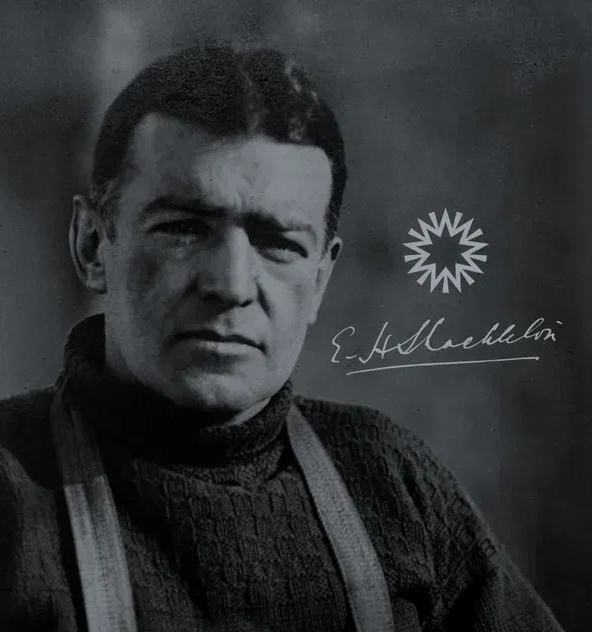
Ernest Shackleton. Photo from shackleton.com
Ernest Shackleton was born in 1874 in Ireland and lived a few miles from where I now live in Dublin. His family moved to London when he was 10. School wasn't Ernest's thing, and when he was 16, he left and went to sea. He worked his way up the ranks, and in 1901, he was part of an expedition to the Antarctic.
Six years later he led an expedition which, for the first time, located the magnetic South Pole. Another six years later, he announced the Imperial Trans-Antarctic Expedition. Endurance was the main ship for that expedition.
Unboxing

The LEGO Endurance arrived in a sizeable box with the usual Icons/18+ design. The sides of the box show a rear and top view, but strangely, one side is just black... there could have been a front view there.
Inside, you'll find 14 numbered paper bags and a box containing an additional 14 numbered paper bags, a brown envelope with sails, an un-numbered bag with masts, strings, and tubes, and an envelope with a single 424-page instruction book. What you won't find are stickers! The count of 28 bags is undoubtedly a reference to the 28 men who sailed on Endurance.
The number of parts in the set, 3011, is very close to 3008—the depth in meters where the wreck of Endurance lies. I wonder if the designer was aware of that. It should have been possible to reduce the parts count by three.

28 numbered bags, and some unnumbered ones
Preparations
Shackleton was very lucky. A Norwegian philanthropist and a Belgian explorer had commissioned the ship Polaris from a Norwegian shipyard. They were planning to use it for Arctic cruises with wealthy clients. When the latter ran into financial difficulties they were forced to abandon their plans and sell the ship. They contacted Shackleton who bought the ship for a fraction of what it would have cost. He renamed it Endurance, after his family motto, and brought it to a shipyard in London to prepare it for his expedition. The modifications he made included installing kennels for the sled dogs.

Shackleton’s mythical ad
There is an image of an ad that Shackleton supposedly placed in The Times. Unfortunately, it is most likely fake. No record of it exists… and would Shackleton or indeed The Times have allowed the American spelling of honour? I think not!
Still, it’s a good story!
The Bow Section
Building a ship traditionally starts with laying the keel. A wooden ship like Endurance would continue with the frames that give the hull its shape, then the planks that form the outer skin. This LEGO model does not follow that tradition as becomes clear a few steps into the build.
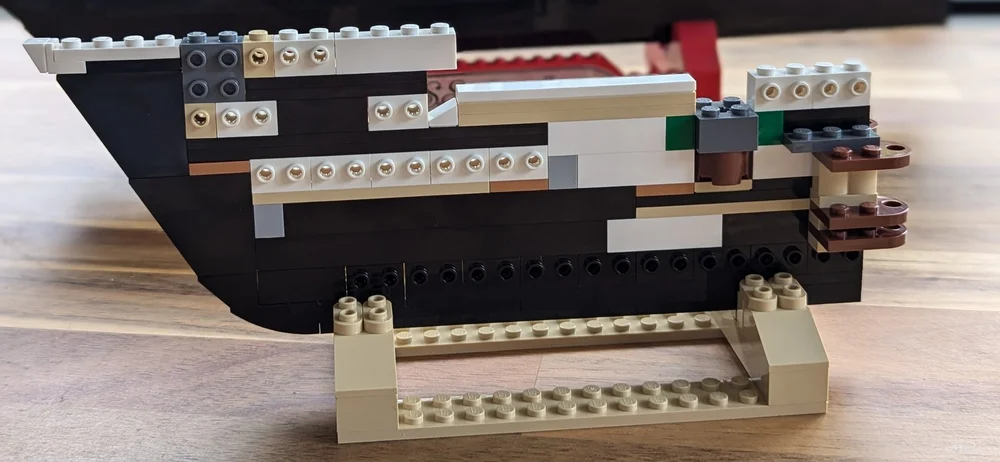
Bag 1 is complete; the core of the bow sits on the temporary stand
The hull is built sideways onto a central spine, using various slopes, arches and curved panels to shape the bow. That sideways build also allows the use of (the back of) 1x4 masonry bricks for a nice plank effect on the deck. The use of Technic gear racks for stairs reminded me of the Maersk container ship. The bow section is 27 studs long and it's finished at the end of bag six. By then you will also have built both the final support stand and a temporary one to hold sections during the build.

The bow section is complete, with a detailed forecastle
The Expedition Begins
Endurance left Plymouth in August 1914, two weeks after the start of World War I. It sailed to Buenos Aires and then to the Grytviken whaling station on South Georgia, an island 800 nautical miles (nm) East-South-East of the Falkland Islands. From there, it set sail for Vahsel Bay in Antarctica.
Only two days into their 1500nm journey, they encountered sea ice, much earlier than anticipated. After that, there were periods when they could sail south and periods when they were stuck in the ice. By the end of February, Shackleton realised they would spend the Antarctic winter in the ice. He expected the slow flow of ice to take them back North to have another attempt during the next spring season.
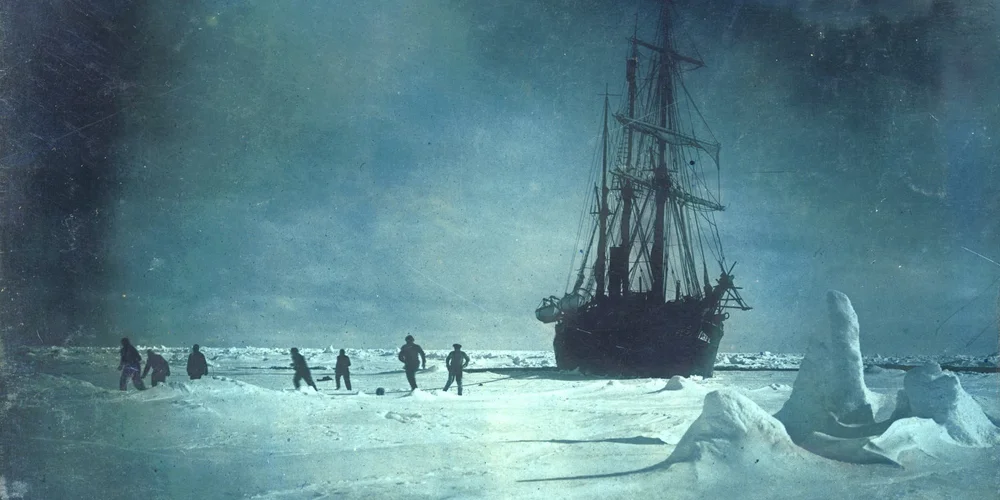
Endurance stuck in the ice. Photo: Frank Hurley/ Scott Polar Research Institute, University of Cambridge
The Midship
The midship section starts the same way as the bow, by building the spine straight up. Next, you add sections of hull and deck sideways. Above deck, there's the dining room and the start of the officers' cabins. The walls of the cabins are built sideways again, like the hull and deck. This section is 28 studs long and has an easier construction because the sides are mostly straight.

Endurance Midship section
After six bags, this hull section is complete and it's time to connect the two sections we've built so far. This is achieved like the sections of the LEGO Titanic that are connected with Technic axles through a series of 2x3 plates with a hole, but unlike the Titanic, the sections are also connected with plates, and the axles are not meant to come out again.
Stuck In the Ice
The hull shape of straight sides with a flat bottom was the main problem that Endurance had once she got stuck in the ice. It meant that there was no way out, and she had to endure the pressure. Another exploration ship, the Fram, had been designed with a different hull shape, more like a bowl. When the ice closed in on that ship, the force of the ice floes lifted the ship up onto the ice where she was then carried along.
Endurance was designed to sail through light pack-ice. The bow was built from layers of oak, reinforced with steel. The hull was also made from layers of oak and 75cm/30" thick in places. That extremely strong hull survived months of pressure from the ice, but by late October, after eight months stuck in the ice, it finally caved. The crew abandoned ship and set up camp on the ice a mile away. Luckily, they were able to take a lot of supplies from the ship before it eventually sank on November 21st.
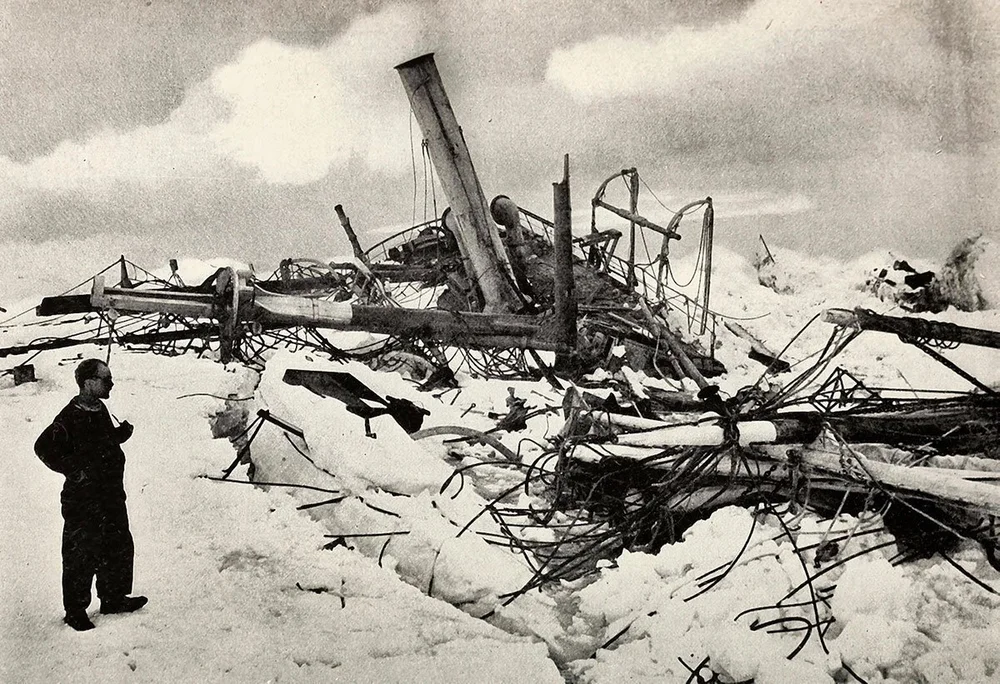
Frank Wild looking at what’s left of Endurance, days before she finally went down.
Photo: Frank Hurley/ Scott Polar Research Institute, University of Cambridge
The Stern

The aft deck, with working steering and Technic gear racks as stairs.
The stern section once again starts with the core, but it's very different from the previous two sections. Bag 15 contains the first printed part, the stern with the name of the ship. Bag 16 contains the parts for two cabins with a detailed interior: the captain on starboard and the navigator on the port side. Here, you will find the second printed tile, a map of Antarctica.
Bag 17 starts with the steam engine, which will be invisible once the ship is finished. Bag 20 contains the aft deck and the working steering.
With the third section complete, it's attached to the first two sections using the same method as before, with Technic axles. The hull is now complete and just needs the bowsprit to be added to reach its full length of 80cm/ 31".

Three Hull Sections

Completed Hull
Reaching Elephant Island

Via Britannica
Shackleton and his crew twice tried to walk along the ice but had to give up after making very little progress. After their second attempt, they built "Patience Camp" on the slow-moving ice. In early April, after living on the ice for five months, the flow that had taken them 100nm north started breaking up.
They packed everything they could in their three lifeboats and set off towards Elephant Island, which they reached after six days of rowing in temperatures as low as -30C.
The Bridge Deck
With the hull and cabins built, the next job in the LEGO version was to build the bridge deck on top of those cabins. The next three bags build the deck in sections. This is where you find the kennels for the 69 sled dogs that were part of the expedition and the funnel for the steam engine. There's also the small matter of 46 skeleton legs to hold the railings...
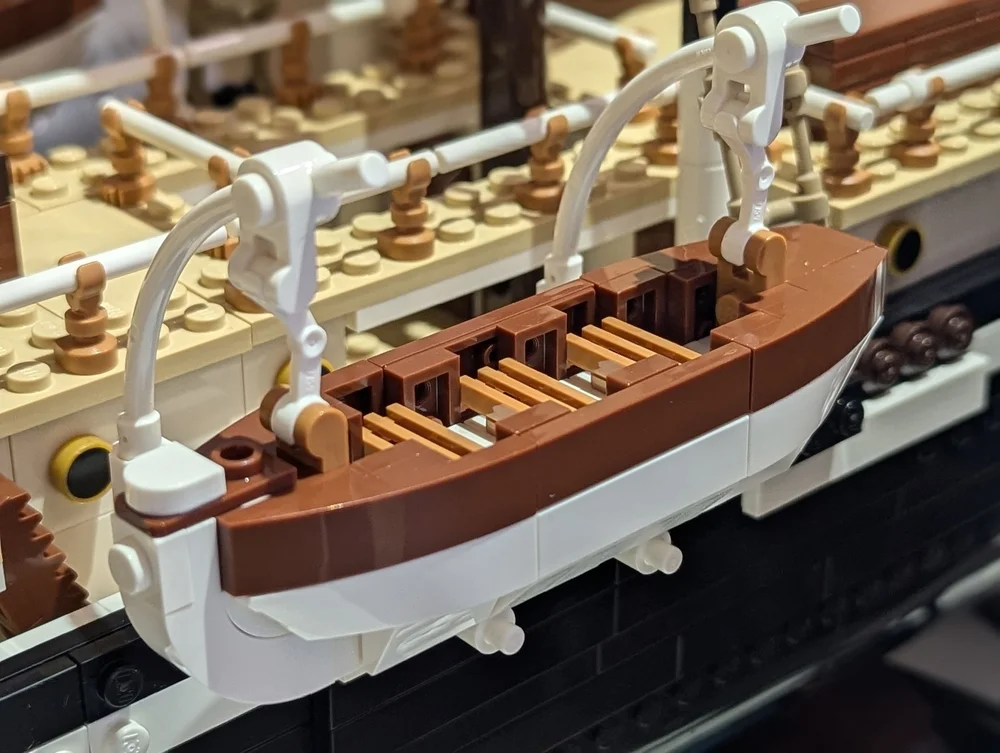
A lifeboat hanging in davits. Behind is the bridge deck with it railing held by skeleton legs.
The next two bags contain the parts for the four lifeboats that you build in pairs. They look very similar, but the second pair are actually a stud longer. They're a nice intricate build, taking more than 60 pieces per lifeboat.
Sailing to South Georgia with the James Caird
While the men on Elephant Island had solid ground under their feet for the first time in nearly 500 days, they were still hundreds of miles from the nearest humans. Their only hope was to get back to South Georgia.
Harry McNish, the ship's carpenter, used his ingenuity and the materials he had to turn the James Caird, one of the lifeboats named after the expedition's sponsors, into a sailboat. Shackleton took five of the men with him and set off for South Georgia, a journey of more than 700nm. They arrived on the island after two weeks, thanks to Frank Worsley's incredible navigation skills.
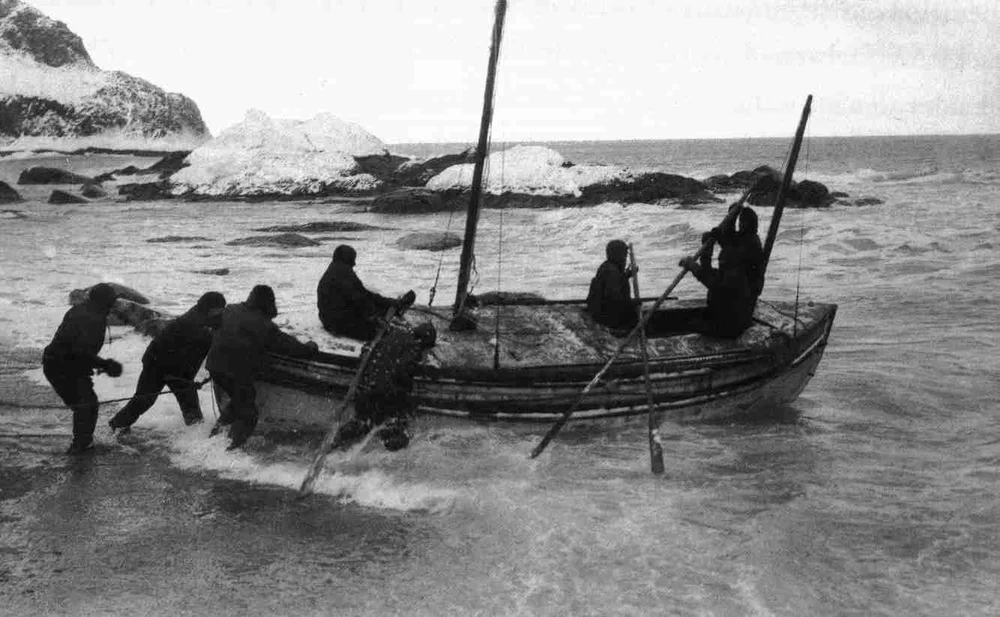
James Caird leaves Elephant Island.
Photo: Frank Hurley/ Scott Polar Research Institute, University of Cambridge
They set up another temporary camp to recover, and after a few days, three of the six started their 40km walk over a mountain ridge to the whaling station of Stromness on the other side of the island, which they reached after a 36-hour non-stop hike.
The James Caird
If you buy the LEGO Endurance when it is released, you will receive a minifig-sized model of the James Caird as a Gift With Purchase. It shows the lifeboat with one of the sleds used to move it along the ice, and with the mast that was added for the journey to South Georgia. The set includes two minifigures: photographer Frank Hurley with his camera, and of course, Ernest Shackleton, adding a few more minifigs to our list of those based on real people.


Peggotty Camp
With three of the 28 men now safe, the next task was going back to Peggotty Camp (named after the Peggotty family in David Copperfield) to get the other three men who had sailed to South Georgia. A whaling ship made the trip, with Frank Worsly on board, and the next day all six were safely in Stromness whaling station. The next task was harder: finding a ship to go back to Elephant Island for the 22 others who had been left there.
Mast and Rigging

Bridge deck, rope ladder and sails
Bags 26 and 27 in the LEGO set build the three masts with the yards, booms and gaffs that hold the sails. The lower sections of the masts use a familiar mast piece that has appeared in pirate and other ships since 2004, while the top sections are made from Technic parts. Only one more bag to go!
That last bag includes the parts for the rope ladders. They are made from flexible hose with grips, a part introduced last year and new here in dark tan, and skeleton arms. But be warned… six rope ladders multiplied by nine steps multiplied by two clips each… Let’s just say this wasn’t my favourite part of the build.
The last steps are for the rigging and sails. The ten sails are very easy to put on; two are on the two long strings for the rigging, and the rest just pop onto ball joints.
The very last piece is the printed plaque, a 6x6 tile. Altogether, the last bag took me nearly an hour.
Back to Elephant Island
Three attempts to get to Elephant Island failed because of the ice. In the end Shackleton managed to borrow a steam tug from the Chilean navy called Yelcho that eventually got him through the ice. The men on the island had kept routines to keep up morale, and had been feeding on seal and penguin. When Shackleton's borrowed ship arrived at the end of August the men had started to give up hope but they were all still alive.
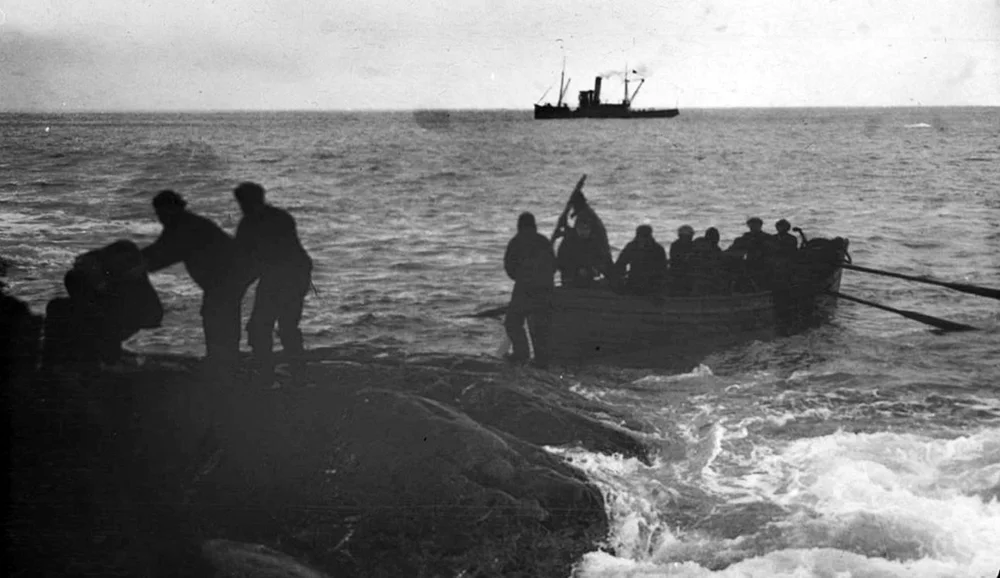
Leaving Elephant Island after four months living in a hut made from upturned lifeboats.
Photo: Frank Hurley/ Scott Polar Research Institute, University of Cambridge
The entire crew made it back to civilisation alive. The animals were not so lucky. I won’t go into details here, but all 69 dogs, the pups that were born during the expedition, and Mrs Chippy, the ship’s cat, all died of various causes.
The Completed Model
The completed Endurance is a beautiful model. It is nowhere near as huge as the Titanic, but at 80cm/ 2'8" long, she's big. The scale is 1:66, or three times the scale of Titanic. It also means that scaling it up to minifig size would make it 1.5 times longer, wider and taller, massively increasing the parts count and cost.
The proportions are pretty accurate, and the colour palette of black and white with tan and brown works well. The sails are made from a very nice material, softer than previous sails I've come across. The designer also found a clever way to use long strings without studs.
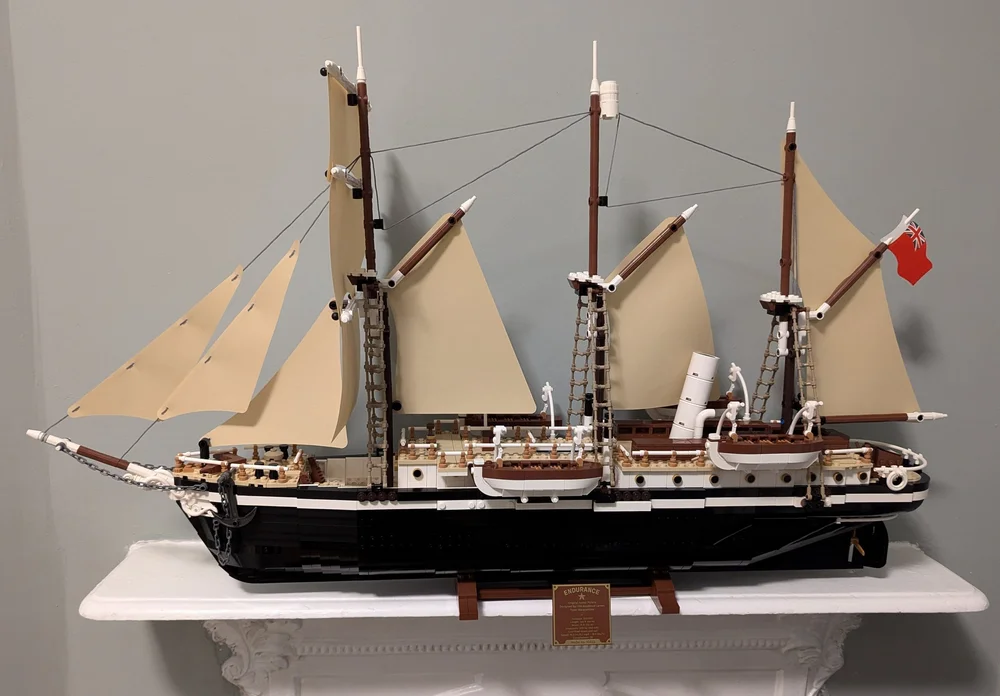
Endurance sitting proudly on the mantelpiece
The last section of bridge deck is easy to remove for a look into the two cabins, which is a nice detail. Reaching the steam engine requires a lot more dismantling. There are some parts in new colours, like the white barrel at the top of the mast. The curved bar in white is not new but very effective here as the davits, the little cranes that hold the lifeboats.
I’ve already mentioned some printed parts. There’s also a 1x1 tile with a compass on the bridge, and pearl gold 1x1 round tiles with a black circle printed on them, which are used to great effect for the portholes. The three-stud wide funnel uses Technic pulleys for the bands, as seen in some photos.
Finding Endurance
A number of attempts had been made to locate the wreck of Endurance. It was finally found on March 9, 2022, by the Endurance22 expedition, organised and funded by the Falklands Maritime Heritage Trust. Endurance sits 9,869ft deep, or 3,008m, on the bottom of the Weddell Sea, about 5.4nm from Frank Worsley's estimated location.
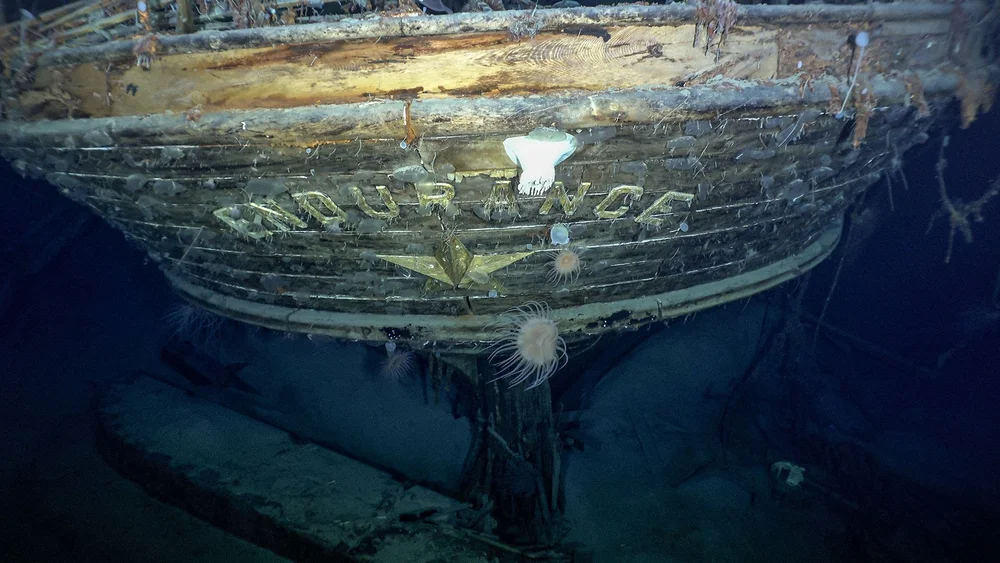
The stern of Endurance after 107 years at the bottom of the Weddell Sea.
Photo: © Falklands Maritime Heritage Trust / National Geographic
It is in remarkable condition after 107 years on the ocean floor. For example, it is in much better condition than Titanic which sank three years earlier and lies at a similar depth.
A Closer Look at LEGO Endurance
Beautiful as the model is, LEGO Endurance is not without flaws. The first very obvious issue is with the sails. Most are loose in one corner. I appreciate that running rigging, the ropes that control the sails, is difficult to create in LEGO at this scale, but the sails look strange without any strings to hold them. For the standing rigging, there are two strings each for the static ropes that hold the masts up, and each mast has two rope ladders. It's cleverly done, but because nothing pulls the rear mast backward, you can't tighten the strings.
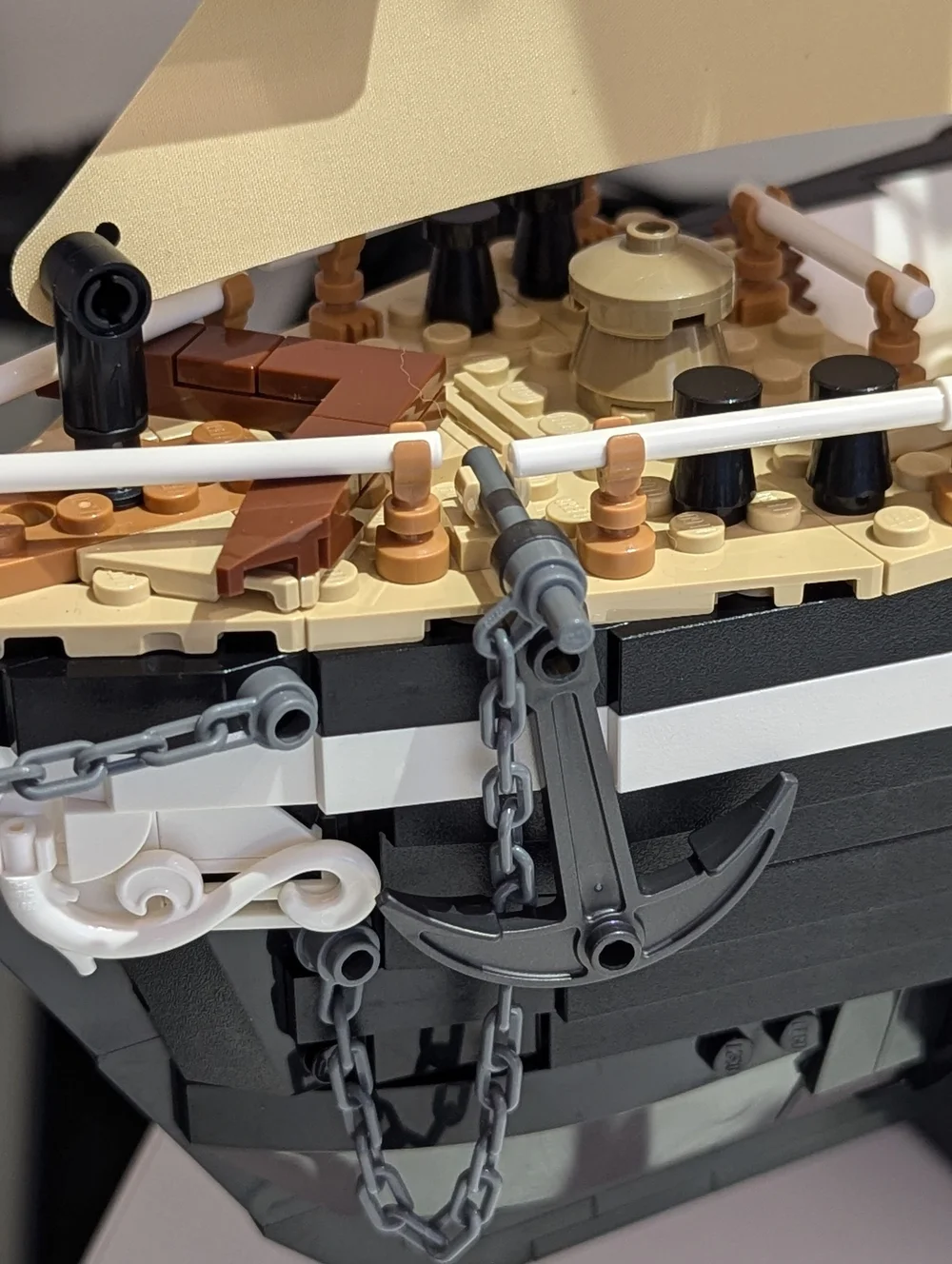
The not entirely correct placement of the anchor
Much is made in the description of having a tiny gearbox and a working rudder. This is very much a static model though, so for me, having the wheel and rudder connected is of little value. I would have preferred a more correct look with chains.
There are some more details that are not as obvious. For example the walls of the cabins curve inwards, which would have been really tricky to do in the model. A few doors are missing as well as a chimney for the kitchen. She should have two anchors and the way the single anchor hangs off the bow is wrong; the anchors should sit on top of the brown V-shape.
That said, the ship was an enjoyable build and looks great.
Ernest Shackleton’s Legacy
While I researched this article, I learned a lot about Shackleton and Endurance, and I have deep respect for what those men did. In the years after his early death (he died of a heart attack aged 47), he was remembered as the explorer of the failed expeditions. His reputation hung in the shadow of Scott and Amunden's successes. Over time, that has changed, and he is now regarded as the hero who led 27 men home through the harshest of conditions and got them all home alive.
Apsley Cherry-Garrard, a member of Scott's Terra Nova Expedition, wrote:
"For a joint scientific and geographical piece of organisation, give me Scott; for a Winter Journey, Wilson; for a dash to the Pole and nothing else, Amundsen: and if I am in the devil of a hole and want to get out of it, give me Shackleton every time.”

The story of Endurance and Ernest Shackleton’s leadership is one of perseverance and resourcefulness in the face of incredible challenges. This LEGO set does more than recreate a historic ship—it invites us to connect with a remarkable moment in history and embark on our own journey of Endurance.
DISCLAIMER: This set was provided to BrickNerd by LEGO. Any opinions expressed in this article are those of the author.
The LEGO 10335 Endurance will be available from stores and online beginning November 29th for around $270 in the US, $350 in Canada, €270 in Europe, £230 in the UK, and $400 in Australia.
What surprised you about the voyage of Endurance? Let us know in the comments below!
Do you want to help BrickNerd continue publishing articles like this one? Become a top patron like Marc & Liz Puleo, Paige Mueller, Rob Klingberg from Brickstuff, John & Joshua Hanlon from Beyond the Brick, Megan Lum, Andy Price, Lukas Kurth from StoneWars, Wayne Tyler, LeAnna Taylor, Monica Innis, Dan Church, Roxanne Baxter, and Steven Laughlin to show your support, get early access, exclusive swag and more.

